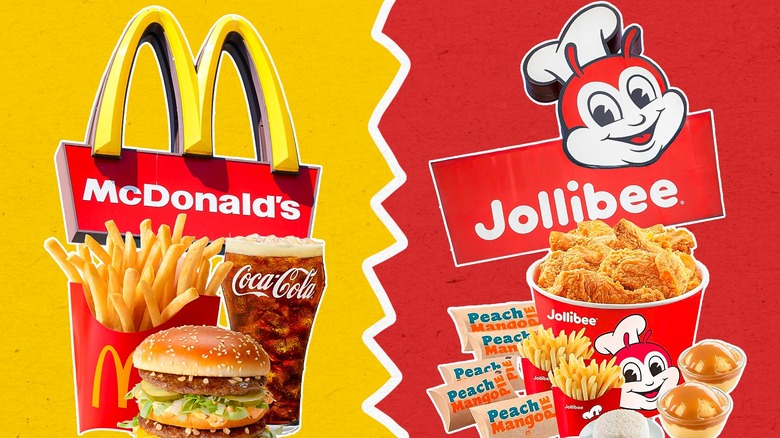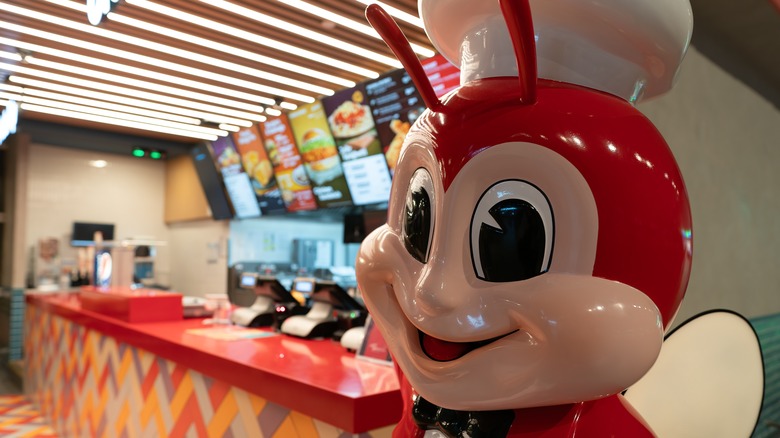McDonald's Vs Jollibee: The Obscure Fast Food Rivalry, Explained
Filipino fast food chain Jollibee provides a remarkable case study in how savvy marketing can create a socio-economic bullseye that even McDonald's hasn't fully managed to hit. Jollibee's origin story starts with a humble ice cream business in Manila, opened in 1975 by Tony Tan Caktiong. In response to customer demand, the business eventually began selling burgers and sandwiches, which became so popular that the company eventually dropped ice cream altogether and rebranded as Jollibee in 1978. The "Jolly Bee" mascot embodies the cheerful, productive buzz of the restaurant as a direct appeal to the national character of the Philippines — a branding decision that would prove critical in the years to come.
By 1981, McDonald's had begun its colossal rollout to the Philippines, putting pressure on smaller franchises to sell out. Tan Caktiong instead flew to the U.S., analyzed what fast food giant McDonald's was doing right, then sought to infuse that model with his unique understanding of Filipino tastes and values. Jollibee's food was sweet and spicy, the vibe was playful and family-oriented, and the prices were lower than McDonald's.
Jollibee effectively harnessed the Philippines' affinity for Western fast food by making it more accessible to the local palate. Decades later, Jollibee's menu still serves up perennial favorites (which we've ranked worst to best) like Chickenjoy fried chicken, Jolly Spaghetti, and the Yumburger. Though McDonald's has attempted to adapt its international menu in a similar fashion, Jollibee's homegrown authenticity helped it capture a 35.7% market share in the Philippines by 2017, compared to Mickey D's paltry 18.8% (via CNBC).
Jollibee is making international buzz
Jollibee has been slowly but steadily expanding abroad, even to the land of the Golden Arches. Its strategy hones in on the Filipino diaspora, offering a taste of home in far-flung locations across the globe. Consumer enthusiasm is evident with each new location that opens, such as the 101st North American grand opening in Seattle, where lines began forming as early as 5 a.m. On social media, personal accounts of homesick Filipinos driving hundreds of miles to get their Jollibee fix are making the rounds.
But Jollibee Foods Corporation (JFC) isn't content just growing its flagship brand — it's made a flurry of shrewd acquisitions both in the Philippines and abroad. Notable among these are its 100% ownership of the American brand Smashburger, its 47% stake in Tex-Mex chain Tortas Frontera, its 70% stake in South Korea's Compose Coffee, and its acquisition of Chinese fast food chain Hong Zhuang Yuan, among many others. JFC is also consolidating its grip over the Philippines' fast food market with a majority stake in BK Titans — better known as Burger King.
It may come as little surprise that Tony Tan Caktiong is now a billionaire. His lofty ambitions include surpassing Starbucks in the Philippines, as well as elevating Jollibee to the top five most valuable franchises in the world by market cap (via Forbes). While it still has a ways to go, Jollibee is the second fastest-growing restaurant brand in the world, showing McDonald's that it's a bona fide industry force.

